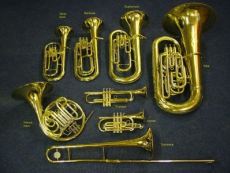
In the previous article, we started to look at the overall style and structure of the Brass family, but in this article, I’d look to take you through the major instruments of the family individually. We’ll look at some fun facts about each of the popular members of the family and maybe discuss some instruments that you’re not so familiar with.
Let’s begin then with probably the most famous Brass instrument, the Trumpet. These are one of the highest members of the Brass family and are probably used in the widest variety of musical genres. They are used in orchestral arrangements, jazz band, big brass bands, and most recently they started to become a trend in pop music, with singers like Jason Derulo and OMI including them in their hits. I can’t say that I’m displeased about this, because the trumpet is actually one of my favourite instruments. Similar to the trumpet is the Cornet, though these are usually found solely in the brass band scene. Thought they look quite similar, the tube increases in width along the whole coil, while the trumpet tube only increases in width right at the end as it flares into the bell shape. This gives the Cornet an equally high, but much warmer and fuller tone. Flugel Horns are also similar. Although their funny name seems to describe them as horns, they are actually much more similar in structure to a trumpet. It once again has a mellower and warmer sound than the trumpet however, due to its significantly wider tube. It is used both in brass and jazz bands.
Horns themselves generally have an Alto range and play the middle parts of the band ensembles, where trumpets usually play the higher parts, and trombones play the lowest. There are two main varieties – the Tenor Horn and the French Horn. The Tenor Horn looks like a big trumpet held vertically, while the French Horn has the iconic circular shape that you’d probably recognise. The French Horn is the lower of the two, since it has a much larger bell shape at the end. If you were to uncoil it, it would be over 6 metres in length, and it has the largest pitch range of any brass instrument, which stretches over 4 octaves or 48 notes.
Slightly lower, are the lesser known Baritone and Euphonium. Both are found mainly in Brass bands, though the Euphonium sometimes appears in orchestral music. Both look like smaller Tubas, and produce notes that are about an octave below that of a trumpet. The Baritone and Euphonium both have slightly different tones, which is the main difference of the two, created by the difference in the shapes of their tubes. The Baritone is usually described as having a ‘brighter’ sound to it, as compared to the ‘darker’ feel of the Euphonium.
Below the Euphonium and Naritone in pitch are the trombones. These are the only instruments in the Brass family that do not use valves. Valves are the holes on the instrument that open and close at the push of a button. This would usually change the pitch of the notes by manually increasing or decreasing the length of the tube. Instead of this, trombones use a slide mechanism, which allows the player to physically push and pull the tube out to make it longer or shorter, which then changes the note being played. There are small and large bore variations to this instrument. The smaller ones are typically used in jazz and pop music. While the larger bore models are used for orchestral music, where the sound needs to be projected further.
Finally, the Tuba is the lowest Brass instrument. It tends to play the bass lines in songs, and is used mainly in the classical genre of music. One might think it would sound harsh being so low, but since the tube extends in size across the entirety of its length, like with the Cornet we mentioned earlier, it actually produces quitter a warm, mellow tone. The full length of a tuba is over 13 feet when uncoiled, and they have the largest mouthpiece of any brass instrument.
Hopefully this article has given you a general overview of the main instruments of the Brass family and you’ve learnt a little more about how each one is used. Next we’re going to look back at both Brass and Woodwind instruments in a specific article about how they’re tuned.
Image from: https://s-media-cache-ak0.pinimg.com/736x/02/93/4d/02934d1da96eb3fbe854f6d370a93d58.jpg

0 Comment:
Be the first one to comment on this article.